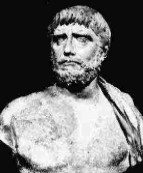Between
800 B.C. and 800 A.D. the Mediterranean coast became a hub of
intellectual activity. The alphabet
seems to have originated from the Sinai
peninsula in Egypt and found its way into Greek, Roman
and Carthaginian colonies through the commercial activity in the
region. In the VIIIth century B.C. the first Olympic
games were held and the first Greek literature
appeared in the works of writers such as Homer
and Hesiod. However,
there was no evidence of mathematical activity until 600 B.C. when the
emergence of two men, Thales of Miletus and Pythagoras of Samos, made
the first mathematical discoveries of this period. Despite the lack of
documented evidence, tradition has nevertheless given a lot of
importance to early Greek mathematics. During the VIth century B.C. the
Ionians, who formed Greek settlements along the
Mediterranean coast, developed their commercial activity with the
Egyptian and Mesopotamian colonies. This gave the Greeks the
opportunity to come into contact with Egyptian and Babylonian culture.
It is highly probable that both Thales and Pythagoras acquired their
knowledge of ancient mathematics from their travels to these regions,
which they later developed back in their homeland.
|
| The
earliest written document about the life and work of Thales is
found in the book "Commentary on the First Book of Euclid's
Elements" written by the philosopher Proclus (410-485 A.D.)
approximately 1,000 years after his death. Proclus writes that Thales
"...first went to Egypt and thence introduced this study into
Greece. He discovered many propositions himself, and instructed his
successor in the principles underlying many other, his method of
attack being in some cases more general, in others more
empirical". Thales is considered to be the first known
mathematician and the creator of
demonstrative geometry. Tradition has lead us to
associate him with the following five
theorems, which were possibly learned on his travels
whilst trading in Babylon, as well as finding a proof for the last
theorem.
|



